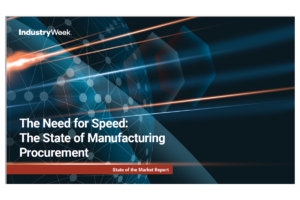
Key Takeaways:
- Procurement officers are playing a more critical role in mitigating challenges due to the pandemic, inflation, and other geopolitical issues
- Greater supply chain efficiency via solutions like aPriori improves forecasting, profitability, agility, supplier networks, reduces recessionary woes, and mitigates material shortages
The Full Article:
Many manufacturers were caught off guard by supply chain disruptions due to the pandemic and other geopolitical issues. A reactionary approach was taken to get through the crisis. Inflation increased, and delays persisted.
A new report from MHI and Deloitte found that 90% of companies are planning to invest more than $1 million in supply chain technology this year to improve supply chain efficiency. Moreover, 38% of businesses plan to spend more than $10 million. It indicates that manufacturers are taking a proactive, rather than reactive, stance to improve their supply chain efficiencies.
Issues that Impede Supply Chain Efficiency
Deloitte’s Global Chief Procurement Officer Survey 2023 noted the chief procurement officer (CPO) role is more complex, especially as they navigate unprecedented supply chain disruption. Additionally, procurement’s increasing value – to mitigate inflation, foster greater supply chain proactiveness, and enable growth – has become more prominent. The rub is that they are expected to do all of this and more, with less. While no one could have predicted the pandemic, war, or inflation, there are common trouble spots that spur supply chain reactivity:
- Lack of forecasting capability. Poor visibility and communication with suppliers will limit your ability to forecast your supply chain access. Without the ability to manage or optimize inventory, you will struggle to control/reduce costs. The Deloitte survey found that only 25% of firms believed they could identify and predict supply disruptions in a timely manner “to a large extent”.
- Limited exposure to potential suppliers. Relying solely on an enterprise resource planning (ERP) system leads to a myopic supply chain. It also limits your ability to explore and assess current OR potential suppliers.
- Inability to pivot quickly due to unavailable materials or supply chain delays. Without visibility or alternative supplier insights, manufacturers cannot respond quickly and proactively to supply chain disruptions. Lack of supplier communication and collaboration further impede their supply chains.
There are several areas where reactionary supply chain management can be remediated. It starts with a solution like aPriori.
Three Strategies to Manage Supply Chain Instability
Boston Consulting Group’s CEO Outlook 2023 found 72% of executives globally said they are focused on decreasing costs in a thoughtful way. Their highest priority is to improve efficiencies to reduce costs rather than making dramatic direct cost cuts. Taking a more proactive approach to your supply chain can pay off in spades, provided you have a strategy in place and the right manufacturing insights solution. Let’s explore three areas that can benefit from proactive supply chain management.
- Ward off recessionary woes. The Deloitte survey revealed that inflation risk is expected to continue and is among the top three risks over the next 12 months. Not surprisingly, 71% said improving margins via cost reduction was a priority. To ward off a potential recession, procurement should conduct a spend analysis to improve margins. Experienced sourcing managers who use a spend analysis typically achieve savings of 3 to 5% of the spend analyzed of their product cost reduction goals. A spend analysis should not be a one-off. It should be conducted on a regular basis to identify any material or manufacturing process outliers. Outliers can be analyzed, and a cost-reduction plan put in place to ensure savings and profitability.
- Avoid putting your supplier eggs in one basket. A KPMG supply chain article said 71% of global companies highlighted raw material costs as their main supply chain threat in 2023. Solutions like aPriori provide end-to-end visibility. Design engineers can create products that work around supply chain issues and related costs while collaborating with cost engineers, procurement, and production. Consequently, they can reduce quoting from several weeks to a few days, meet schedules and target pricing, and improve cash flow. Procurement also can quickly identify, select, and onboard suppliers, facilitating predictive sourcing and ensuring more negotiation transparency and supplier visibility.
- Expand and improve the supplier network. Challenges like organizational silos or no process standardization were cited by more than 25% of CPOs among their top three issues in the Deloitte survey. The right tools can maximize and multiply your supplier network. aPriori has nearly 90 regional data libraries (RDLs) and over 440+ manufacturing process models. They can identify the best supplier type aligned with your desired parts in your preferred geographic areas, using the most optimized manufacturing process. Manufacturers can digitally recreate their suppliers’ factories to better understand costs associated with cycle time, materials, etc. This visibility is essential to sourcing competitively, particularly for those organizations that are expanding their supplier reach geographically. Those creating new products will need this visibility as well to identify if and where suppliers exist to provide parts. Finally, you will streamline supply chain operational efficiency (with 74% of Deloitte CPOs making this a number one priority). You will gain more agility and responsiveness to manage any supply chain issue without negatively impacting your operations or bottom line.
Learn how Signify’s procurement team went from analyzing 1000 to 10,000+ parts annually.
Bringing Procurement and Supply Chain Visibility to the Ball
For too long, procurement has worked in obscurity and through the veiled lens of the supply chain. By bringing them to the forefront, manufacturers have a prime opportunity to optimize their supply chain efficiency, mitigate inflation, and improve cost transparency and resiliency to weather any disruption.
The Deloitte survey concluded that procurement and supply-related risks continue to increase. Forty-three percent of surveyed CPOs cited a significant increase in overall procurement risk compared to 20% in the 2021 study. The KPMG article cited that more than six out of 10 global organizations anticipate geopolitical instability will be detrimental to their supply chains in the next three years.
Procurement has become a vital asset in mitigating supply chain issues, improving supplier relations and negotiations, securing optimal pricing and quality, and facilitating faster time to market. Solutions like aPriori provide critical insights into the design, cost, sustainability, and supply chain early in development, giving procurement a distinct advantage to not only stay one step ahead of supply chain issues but maximize opportunities as well.
Is Your EV Sourcing Keeping Pace with the Market?
See how Eaton innovated, sourced, and accelerated time to market with manufacturing simulation






